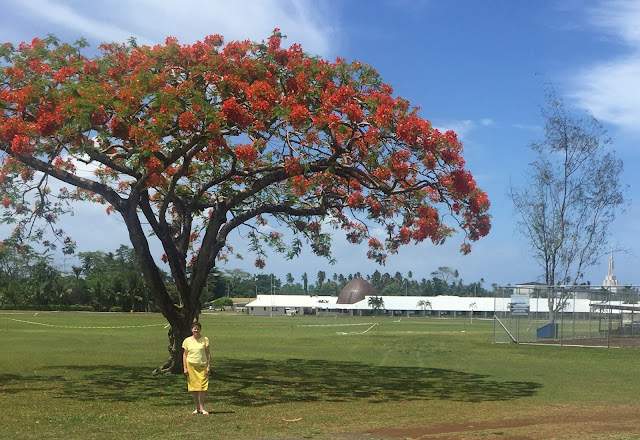December 25th is almost upon us, and the Spirit
of Christmas is in abundance even in these hot and humid islands of the South
Pacific. The Prime Minister’s Office of the Government of Samoa and The Church
of Jesus Christ of Latter-day Saints have teamed up to produce a week-long
series of Christmas pageantry. Each
night various church denominations are invited to present songs and dances on
the lawn in front of the Government Building.
 |
| Samoa Government Building |
Elder and Sister McBride have helped in the production of
the live nativity scene starring young full-time missionaries (and a couple of fairly
well-behaved lambs). The young men and
women have to stand for about two and a half hours every evening for a
week. Despite the heat and humidity,
they have made no complaints at all. And the audience loves them! Each night
parents bring their children up after the performances to have their pictures
taken with our nativity scene. (As we write this, we are watching the recorded telecast of the program on Samoan television.)
 |
| Our Live Nativity Scene |
Sister McBride and Sister Afulua (she is the cook in the
Mission Home) have played major parts in making the costumes. They have collected bits and pieces of
material from different places around the island; cut up old dresses (including
one prom dress); altered existing robes (including even an abaya and a thobe from the Middle
East, making us homesick for our dear friends in Saudi Arabia); and sewed and sewed and sewed. Their final products are nothing short of
magnificent. Each night we take the sweat-soaked costumes home and wash and dry
them.
 |
| Sister McBride and Sister Afulua in the middle, our seamstresses |
For Sunday night’s program, Elder McBride was surprised when
he was asked to give the invocation. He
did so, in Samoan. His prayer included a
request of the Lord that He would hold back the rain. It had rained a lot that day, and there was
concern that more heavy winds and rain could cancel the program. There was no
rain that night, but there was a nice cool breeze that kept things from being
too hot. Afterwards, one of the security guards (not a member of the Church),
commented to one of our members that the Lord had answered the prayer of the
Mormon palagi.
In the meantime, our day jobs continue. We greatly enjoy visiting the homes of the
missionaries; inspecting them for cleanliness; and checking on the general health
of the elders and sisters. We are becoming
experts on the treatments for boils, bed bugs, mosquito bites, and dengue
fever.
 |
| We love our missionaries! |
Sometimes we meet up with unwelcome guests at some of these
missionary houses:
 |
| Sister McBride did not like this visitor |
Every other week or so we do get to take a few minutes for
fun. We stopped one day on our travels
to see the magnificent Fuipisia Waterfall.
(You probably can’t see this short video clip from the email on your
hand-held device; you will have to click on the webpage and scroll down to it.) If you can hear Elder McBride on the video,
you will hear him say that some 35 years ago, when his father and mother
visited Samoa to teach some speed reading classes, his mother stood right about
where Sister McBride is standing:
We also visited what must be one of the most beautiful
lagoons in the world, and we went swimming and snorkeling there. This is Vavau Beach, and Elder McBride and
his companion occasionally found it necessary to take their weekly baths here
long ago. (Not a bad picture,
considering it was taken with an iPhone 6):
We thank Our Heavenly Father for this great opportunity of
serving as missionaries in Samoa. We love to see the temple here, a place of love and beauty. We add our testimonies that it is the House of the Lord.
 |
| The Samoa Temple of The Church of Jesus Christ of Latter-day Saints |
And we
thank Him especially for the birth of our Lord and Savior, Jesus Christ. Merry Christmas to all!
 |
| Picture from LDS Media Library |






















































